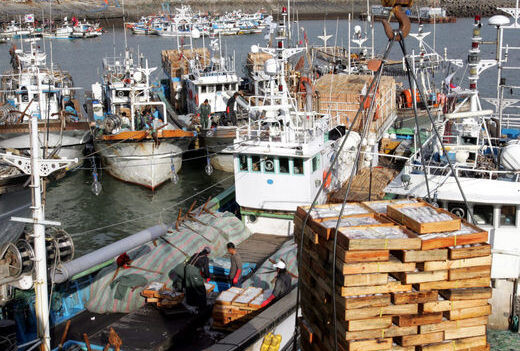hankyoreh
Links to other country sites 다른 나라 사이트 링크
With young fish being hauled in, future catches uncertain

At dawn on November 7, silver hairtails were briskly being traded at a Busan fish market. On that day, 62 tons of hairtails were sold. Over two-thirds of the fish sold, however, were 20-30 centimeter young hairtails. So far this year, about 19,000 tons of hairtail younger than a year old were sold, 1.8 times more than the amount of adult fish sold.
In the meantime, an Incheon fisheries cooperative market is full of yellow croakers, but more than half are young fish, shorter than 20 centimeters. Just one or two boxes out of 100 contain grown-up croakers.
Before long, South Korea may not see fish such as the hairtail or yellow croaker caught in the wild. More than nine of these species of fish inhabiting the waters near the nation’s shores are too young to reproduce.
According to data from the National Fisheries Research and Development Institute, 99.1 percent of hairtails and 93.5 percent of yellow croakers living in South Korean coastal fishing waters are not of reproductive age. In the case of Spanish mackerel, a full 100 percent were too small to reproduce. In the 1980s, mature fish amounted to about 40 percent of the total catch, but the figure fell to less than 20 percent in the past five years. Such a phenomenon is more serious off the west coast, attributed to coastal land reclamation work and pollution.
"If such a situation persists, the catch will be reduced to about half in 10 years, and the nation will lose the base of its fishing industry," said Yang Dong-yeop, an official of the Ministry of Maritime Affairs and Fisheries.
Catches are on the decrease, and large fish are disappearing, according to data from the Ministry of Maritime Affairs and Fisheries. The total catch from near-shore fishing fell to 1.1 million tons last year, from 1.7 million tons recorded in 1986. In addition, the hauls being brought in are of fish that are sold at low prices because they are easier to catch at the surface of the sea, as opposed to more profitable, deeper-dwelling species such as the yellow croaker, which are getting harder to catch. This all spells harder times for the fishing industry.
Editorial・opinion
![[Column] Has Korea, too, crossed the Rubicon on China? [Column] Has Korea, too, crossed the Rubicon on China?](https://flexible.img.hani.co.kr/flexible/normal/500/300/imgdb/original/2024/0419/9317135153409185.jpg) [Column] Has Korea, too, crossed the Rubicon on China?
[Column] Has Korea, too, crossed the Rubicon on China?![[Correspondent’s column] In Japan’s alliance with US, echoes of its past alliances with UK [Correspondent’s column] In Japan’s alliance with US, echoes of its past alliances with UK](https://flexible.img.hani.co.kr/flexible/normal/500/300/imgdb/original/2024/0419/2317135166563519.jpg) [Correspondent’s column] In Japan’s alliance with US, echoes of its past alliances with UK
[Correspondent’s column] In Japan’s alliance with US, echoes of its past alliances with UK- [Editorial] Does Yoon think the Korean public is wrong?
- [Editorial] As it bolsters its alliance with US, Japan must be accountable for past
- [Guest essay] Amending the Constitution is Yoon’s key to leaving office in public’s good graces
- [Editorial] 10 years on, lessons of Sewol tragedy must never be forgotten
- [Column] A death blow to Korea’s prosecutor politics
- [Correspondent’s column] The US and the end of Japanese pacifism
- [Guest essay] How Korea turned its trainee doctors into monsters
- [Guest essay] As someone who helped forge Seoul-Moscow ties, their status today troubles me
Most viewed articles
- 1[Column] The clock is ticking for Korea’s first lady
- 2Hong Se-hwa, voice for tolerance whose memoir of exile touched a chord, dies at 76
- 3[Column] Has Korea, too, crossed the Rubicon on China?
- 4After 2 months of delayed, denied medical care, Koreans worry worst may be yet to come
- 5[Correspondent’s column] In Japan’s alliance with US, echoes of its past alliances with UK
- 6US overtakes China as Korea’s top export market, prompting trade sanction jitters
- 7All eyes on Xiaomi after it pulls off EV that Apple couldn’t
- 8[Photo] Smile ambassador, you’re on camera
- 9Samsung barricades office as unionized workers strike for better conditions
- 10S. Korea “monitoring developments” after report of secret Chinese police station in Seoul